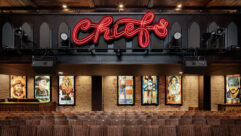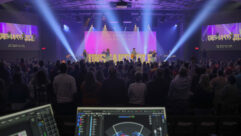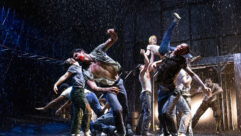
Arizona State University, ranked among the top research universities in the United States, is also one of the largest public universities in the nation by enrollment, with a student body numbering approximately 72,000. ASU continuously renovates and expands the infrastructure of its five campuses spread across the Phoenix metropolitan area and recently upgraded one of its lecture halls with the installation of a dual-purpose L-Acoustics Syva and ARCS WiFo (Wide and Focus) speaker system provided by Sound Image, which is headquartered in Southern California.
“In a handful of the lecture halls, they’ve had real difficulties with speech intelligibility and being able to do larger presentations that involve wireless microphones,” says Sound Image Sales Engineer Ben Davis, who works out of the company’s Tempe-based contracting division office. “We’ve done a few projects for them in different venues that have really changed their experience. We’ve spent a lot of time and detail on coverage and trying to create better speech intelligibility, which is obviously really important in a teaching environment.”

L. S. Neeb Hall, one of the largest lecture halls on ASU’s historic Tempe campus, has a fan-shaped seating area with a capacity of nearly 450 people. Davis was tasked with designing a speaker system that could support two main functions. “They wanted to do music and video presentations as well as speech, so I looked at it from a two-system approach: one focused on speech and one focused on music and media reproduction.
“For the speech side, I wanted a single source that would be able to cover the wide fan shape. When I saw Neeb Hall, I instantly thought of L-Acoustics’ ARCS WiFo because of the coherence of a horizontal array that these boxes can give. Speech intelligibility is always great. I modeled a horizontal array of four ARCS Wide speakers powered by LA4X and it worked out well. We had to create an envelope from a rejection standpoint for an area where a presenter could walk without having a gain-before-feedback issue. It had to be a pretty wide area as they move around and even step off the stage.”

With respect to the music and media system, the previous loudspeaker speaker system had been installed in small cavities on either side of the wide stage. “With these cavities, I was limited on the size of the speaker,” says Davis. “Looking at the slope of the seating section and trying to get even, linear front-to-back coverage, I looked at L-Acoustics’ new Syva. When I modeled it, I found that the natural vertical coverage of the system fit the slope of the room really well and also gave me the horizontal coverage that I needed. I also wanted to stick with the same sonic signature, and Syva marries very well sonically with the center cluster.”
Introduced a year ago, Syva incorporates six medium-frequency and three high-frequency speakers in a J-shaped progressive curvature format cabinet that offers a directivity pattern covering 140 degrees in the horizontal plane and 26 degrees in the vertical. When combined with a Syva Low high-power subwoofer, which houses a pair of K2-grade 12-inch speakers, it generates a maximum SPL of 142 dB. “With Syva and Syva Low coupled together, it gave me a nice full-range box for the media,” says Davis. “I have them toed-in probably about five degrees to try and keep the energy off the walls.”
Davis had a choice of speaker brands but zeroed in on L-Acoustics as the ideal solution, he says. “We always look for the right tool to fix a problem, and having used L-Acoustics in the past, one of the things that I appreciate is how natural-sounding their speakers are. It doesn’t take much to make the system sound fantastic, right out of the box.”
The space is used for a variety of performances and presentations in addition to lectures, so Davis also integrated a Biamp Systems Tesira DSP unit and AMX panels that enable users to easily switch the system for either speech or program playback. Ultimately, he reports, “Everything performed the way it modeled. The system sounds really good and the client is very happy with it.”
“Speech intelligibility is the most important element of any classroom space and the quality of audio for media playback has a tremendous effect on the impactfulness of the content,” confirms ASU Systems Analyst Principal Sean Snitzer. “Sound Image was able to leverage an advantageous mix of unique L-Acoustics products within the classroom space that produced a dramatic improvement with very limited infrastructure requirements.”
For more info on ASU’s Neeb Hall, visit www.asu.edu. Sound Image can be found online at www.sound-image.com.









